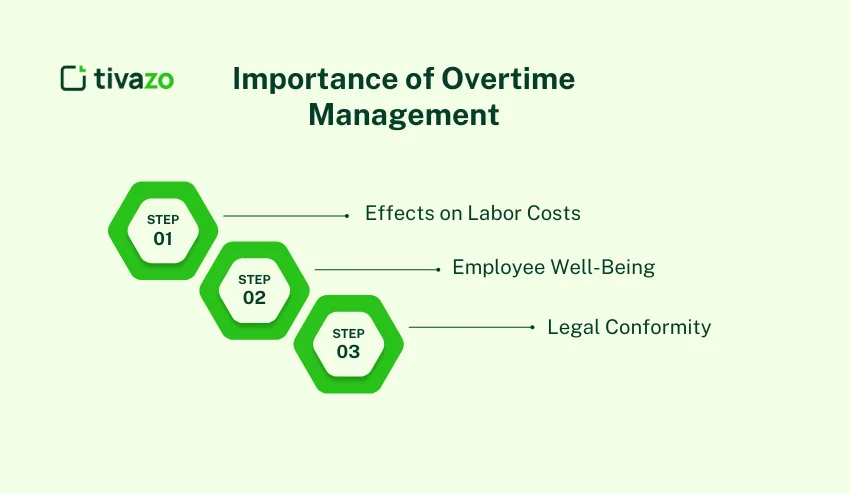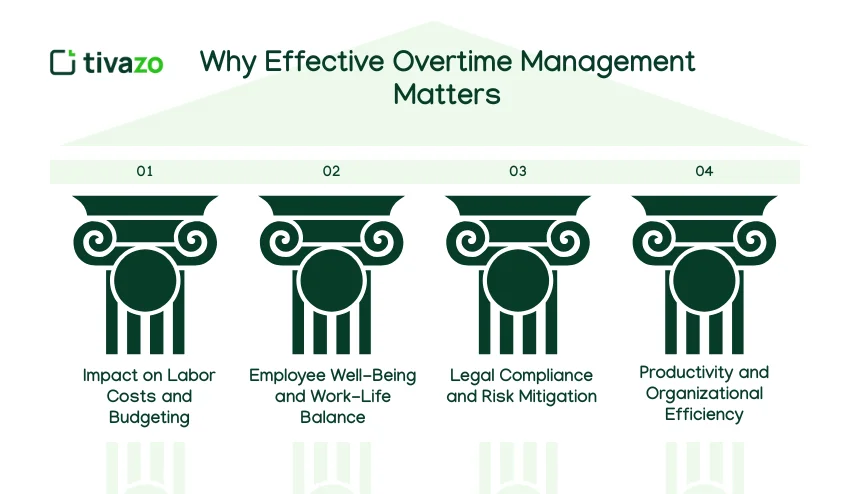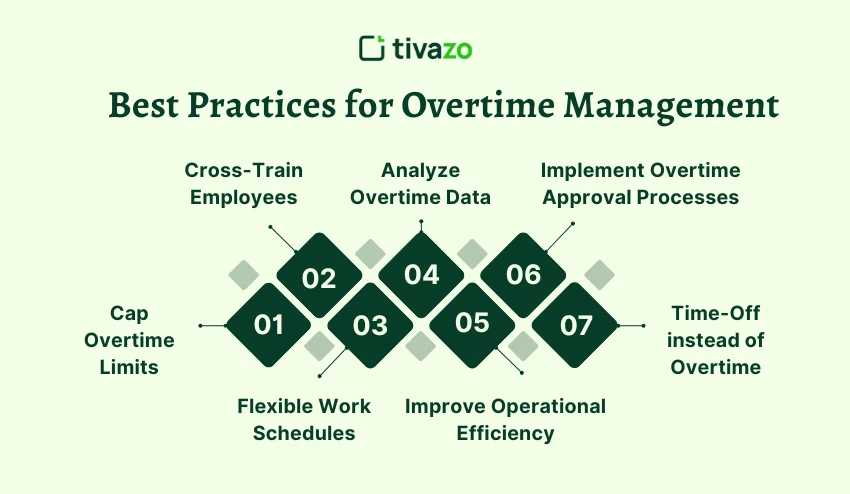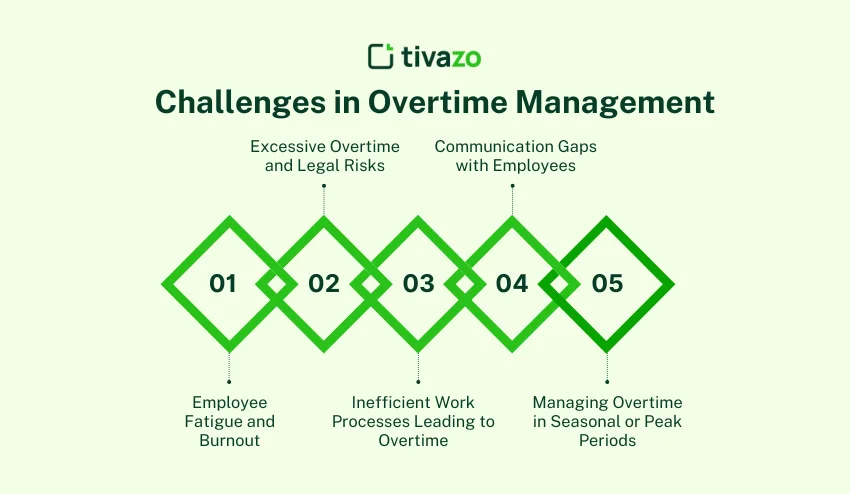Time management and Overtime management are important elements of a functioning and conforming business. The modern competitive environment emphasizes the need to balance labor costs and employee well-being. Regardless of whether you are a small business owner taking charge of a large team, the issue of overtime management can greatly affect your budget and your ability to maintain employee morale.
Not only does effective overtime management allow the management to keep down costs, but it also creates a more satisfying and fruitful workforce. With the application of the appropriate strategies and tools, companies can minimize burnout, enhance efficiency, and make sure that overtime is an opportunity to be utilized and a positive influence on the company and its workers.
Key Highlights:
- What is Overtime Management
- How do you manage overtime effectively
- Importance of Overtime Management
- Why Effective Overtime Management Matters
- Key Components of Effective Overtime Management
- Best Practices for Overtime Management
- The Role of Employee Engagement
- Challenges in Overtime Management
- How Tivazo Helps
What is Overtime Management?
The overtime management is the strategic management of working hours of the employees that are outside the normal working hours in a bid to maximize productivity, remain within the working labor laws, and also ensure a healthy work-life balance for the employees. Management of overtime also involves employing proper time tracking, developing effective guidelines on when overtime should be used, training employees to evenly disperse the workloads, and using software solutions to monitor and analyze the patterns of overtime.
How do you manage overtime effectively?
Handling overtime begins by ensuring you have clear rules, correct tools, and concentrating on ensuring that things are in balance in terms of productivity and the well-being of your team. Through a mix of clever policies, time-saving technology, and a couple of simple best practices, you can reduce the number of unnecessary costs on overtime and produce schedules that are both fair and manageable to all involved. Through the proper strategy, you would be able to maintain your team, engage and maintain them, and be within budget.
Importance of Overtime Management in the Workplace
The management of overtime is a very important issue in keeping businesses efficient, compliant, and in a sound financial condition. Unmanaged, the overtime can easily get out of control and result in major challenges that will impact the company and its employees. So why is overtime management so significant:

- Effects on Labor Costs: When overtime is not controlled, it will increase your payroll expenses, and that will be a huge impact on the bottom line.
- Employee Well-Being: Overtime may lead to feelings of burnout, which has implications on employee morale and productivity.
- Legal Conformity: Poor tracking and non-observance of the overtime regulations may cause legal penalties and fines.
Why Effective Overtime Management Matters
Management of overtime is also a critical element of ensuring that a balance is maintained between the business needs and the welfare of the employees. In the right hands, overtime may prove to be a handy weapon in order to facilitate output at times of the highest demand. Nonetheless, when it is not handled properly, it may cause several financial, legal, and operational problems. Why is managing overtime so important to your business? Here is why:

1. Impact on Labor Costs and Budgeting
Often, the peak periods require overtime, which is normally acceptable. However, when mismanaged, overtime may result in skyrocketing labor expenses. With close monitoring of overtime, it will be easier to predict the costs and distribute resources more effectively.
2. Employee Well-Being and Work-Life Balance
The amount of overtime that employees are supposed to work directly determines the health and happiness of the employees. Uncontrolled overtime results in burnout, stress, and employee turnover, and these may adversely affect productivity.
3. Legal Compliance and Risk Mitigation
Strict legal provisions are involved in the handling of overtime, especially in the U.S. (e.g., Fair Labor Standards Act – FLSA). Lack of compliance may lead to fines, legal suits and loss of reputation to your business.
4. Productivity and Organizational Efficiency
Too much overtime will eventually lower the productivity of the employees. Overworking of employees will reduce their productivity and this will create inefficiencies in the workplace.
Key Components of Effective Overtime Management
To handle the overtime situation effectively, companies should adopt important measures that would make compliance a factor as well as encourage fairness and employee burnout. These aspects are essential to developing an effective, sustainable overtime policy that considers the best interests of the business and the welfare of employees. We shall discuss some of the key components of an effective overtime management system:
- Clear Overtime Policies
- Set guidelines on when overtime is acceptable, how it is approved, and any restrictions that may be observed. Clear policies lessen misunderstanding and help employees know what is expected.
- Time Tracking and Reporting Tools
- In order to track the number of overtime hours, it is necessary to implement time tracking software. There are tools such as Tivazo that can aid in automating the time tracking system and give real-time reports to conduct compliance and maximize overtime hours.
- Compliance with Labor Laws
- You need to learn the legalities of overtime in your area. The U.S. imposes some overtime remuneration and restrictions, which have not been met, and this may lead to serious consequences.
- Monitoring Employee Workloads
- Regularly review the workload that is allocated amongst your employees to avoid overworking. The balancing of work represents one of the main methods of avoiding burnout and reducing the use of unnecessary overtime.
Best Practices for Overtime Management
Effective management of overtime should be proactive in a manner that meets the needs of the business and at the same time does not interfere with the welfare of the employees. It is possible to make sure that the use of overtime is effective, and there is no burnout or excessive expenditures with the implementation of the right strategies. The main approach to overtime management that can assist you in controlling and making it more productive is seven-fold:

1. Cap Overtime Limits
Limiting overtime hours can be used to eliminate fatigue and burnout of employees. One of these is to create effective limits that are reasonable and not overly long, so that the employees are not always under stress trying to work after the normal work-life balance.
2. Cross-Train Employees
Cross-training also allows the employees to work in other areas, hence reducing the workload, which is highly distributed. This will contribute to the fact that a single individual will not always have to work overtime, and also increase team flexibility and cooperation.
3. Flexible Work Schedules
Flexible working hours can be provided so that the employees can have time to take care of their personal matters and still work. This minimizes overtime work and enhances job satisfaction and retention of employees.
4. Analyze Overtime Data
Trends in overtime Use data to monitor the trends in overtime and identify areas where there is inefficiencies or too much overtime. Frequent analysis assists in identifying underlying causes and enables one to adjust workload distribution or processes.
5. Improve Operational Efficiency
Overtime can be minimized by streamlining of work processes and eradicating inefficiencies. Incorporation of lean practices or process modifications can be used to make sure that your team is working at optimal efficiency, reducing unnecessary overtime.
6. Implement Overtime Approval Processes
Request that overtime work must be pre-authorised before it is undertaken. This will assist in making sure that overtime is applied in a planned and not a default manner based on the demands of the work.
7. Offer Time-Off instead of Overtime
One of the most effective ways to balance additional hours and rest is to give employees the option to take time off if they work more hours than they have time off. This would help limit burnout and ensure morale is not compromised while also fulfilling business needs.
Tools and Technology for Overtime Management
Use of the right tools and technology can enhance the management of overtime to a great extent, as it simplifies the tracking, compliance, and minimizes the errors made by the administrative side. The following are some of the necessary tools and technologies a business could use to effectively deal with overtime:
1. Overtime Management Software: Features to Look For
The correct software will assist in making your overtime management simpler. Find the tools that will provide automated timekeeping, real-time reporting, and be integrated with your current HR systems.
2. Automation and Time Tracking Solutions
Automation helps to remove human error and time. Track employee hours automatically using time-tracking solutions. The tools provide compliance and correct calculation of overtime.
3. Integrating Overtime Management with HR Systems
Combining your overtime control with your HR and payroll software will make sure that it is well tracked and minimizes the chance of payroll errors. It is time-saving and more accurate through this integration.
The Role of Employee Engagement in Overtime Management
Managing overtime is dependent on employee engagement. Having open discussions on the expectation of overtime will guarantee that all are on the same page, hence there will be no frustration and more importantly, equity will be practiced. Employees would also be motivated and interested when they know why overtime is being done.
Employees should also be allowed to have some say in the overtime assignments as this will boost morale as it makes them feel that they are in control. Nonetheless, the balance between addressing company requirements and taking into consideration the preferences of the employees should be found.
Challenges in Overtime Management and How to Overcome Them
The overtime management is also associated with its issues, particularly the need to address the balance between the requirements of the business and the welfare of employees, and the legal provisions. These challenges are the first to be identified and thus solved early before things go wrong in the long run and disrupt the productivity, employee morale, and compliance. The following are the typical pitfalls in overtime and how to get out of them:

1. Employee Fatigue and Burnout
Regular overtime may result in burnout, causing poor productivity. This can be prevented by giving proper rest, handling workloads, and even distributing them fairly.
2. Excessive Overtime and Legal Risks
Too much overtime creates a risk to the law. Make sure that the labor laws are adhered to through stringent monitoring and adherence to the maximum overtime hours and compensation.
3. Inefficient Work Processes Leading to Overtime
Your processes may not be efficient and that is why you may be forced to have unnecessary overtime. Workflows should be reviewed and streamlined on a regular basis to reduce instances of overtime work.
4. Communication Gaps with Employees
One thing that may cause confusion and frustration is the absence of open communication when it comes to the expectations of overtime. Make sure that you communicate openly and frankly with your employees about overtime work.
5. Managing Overtime in Seasonal or Peak Periods
Overtime is not very avoidable in peak seasons. Get ready by recruiting temporary staff or changing the work schedule to match demand without overwhelming your permanent staff.
How Tivazo Helps in Overtime Management
Tivazo simplified the time tracking of overtime, automated time tracking inside the company and hence the records are accurate, and non-payment or any other non-observation to the labor laws are reduced. The software gives alerts when the overtime limits are exceeded, and managers can intervene before the problem gets out of hand and ensure that the cost of overtime does not get out of hand.
Moreover, the capability of Tivazo to monitor the activity of its employees, as well as data analytics, assists the business in optimizing its staff and avoiding unwarranted overtime. Through trend analysis and workload, Tivazo will deliver insight to facilitate the efficient allocation of tasks and operational efficiency that will be beneficial to employees as well as the bottom line.
Conclusion
Overtime management is very critical in order to reduce the labor cost, enhance the satisfaction of the employees, and also in order to avoid legal non-conformity. Through best practices and use of the appropriate tools, businesses can make sure that overtime is beneficial to them and does not work against them.
These are just some of the measures you can take to streamline your overtime management by doing them today. Through this, you will be able to save on costs, increase employee satisfaction, and ensure that labor laws are met by adopting the right tools and practices.




